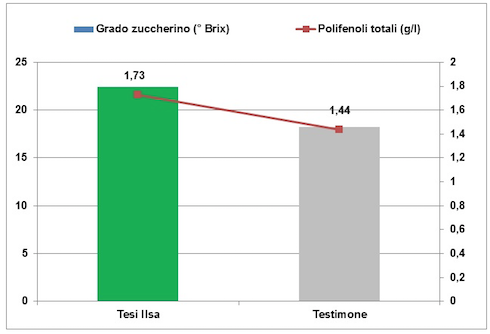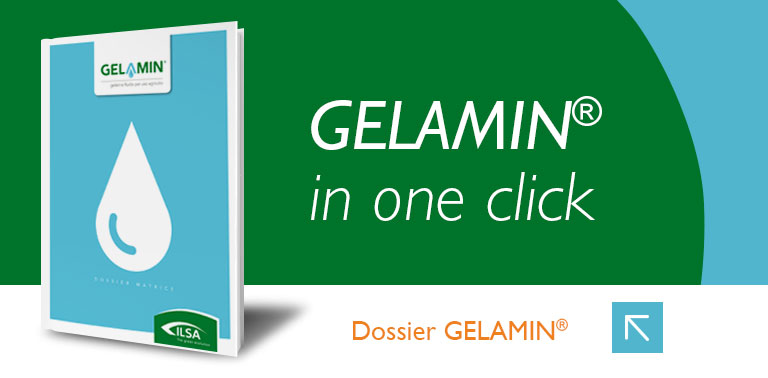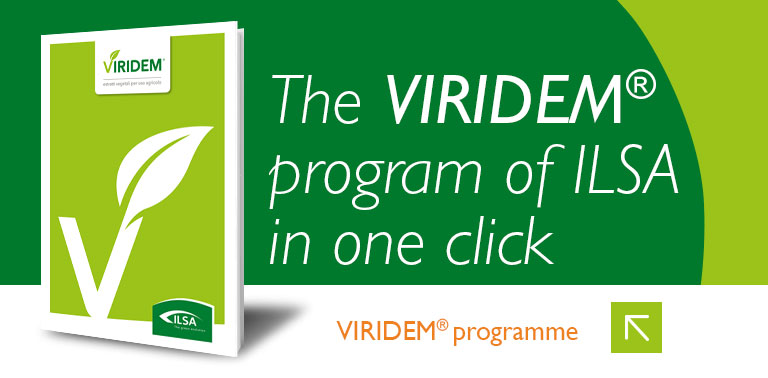Editorials
With ILSA’s natural biostimulants, it is possible to achieve a higher degree of °Brix and polyphenols
25/05/2017
Gaining productive yields every year and increasing the quality of grapes for winemaking are among the goals of both those who produce and directly vinify, and those who consign grapes to the cellar plant. In recent years, Ilsa has followed many wine growers throughout Italy, listening to their needs and setting up specific strategies to increase the quality and quantity of wine. With specific processes such as thermal hydrolysis, enzymatic hydrolysis and supercritical CO2 extraction, Ilsa has been able to give winemakers the tools to reduce stress on the vines, allowing them to express their full potential at the same time. In recent years, the activity of Ilsa’s agronomists has focused on the development of natural, plant-based biostimulants that increase photosynthetic activity, the resistance of the grapes and the thickness of the peel, while also reducing physiological stress during ripening. The final quality, in fact, is achieved if the vine has regularly performed all phases of the phenological cycle, during which it produces sugars and other metabolites that contribute to the final quality of the must. This is why IlsaC-on and IlsaGrader have become the basic tools for wine growers who want to obtain healthy, uniform bunches. In the cellar, this translates to a high content of polyphenols, APA, and – above all – a high value in °Bx, which consequently increases their income

 Comparison of Montepulciano grapes treated with IlsaC-on + IlsaGrader (pictured above), with respect to the witness (pictured below).
Comparison of Montepulciano grapes treated with IlsaC-on + IlsaGrader (pictured above), with respect to the witness (pictured below).
The applications of the two Ilsa biostimulants made it possible to obtain more regular clusters, with less incidences of rotten clusters.
In tests from the past six years, the application of the Ilsa biostimulants from the Viridem® Programme has always provided better results than untreated vineyards or the use of other commercial products: it increases °Bx grades and polyphenol content, without causing a pH increase. As an example, here are only two of the numerous tests carried out on the most important vines in Italy – the Primitivo and Montepulciano vineyards in the south of Italy.
On both varieties, IlsaC-on applications, applied at flowering with doses of 1.5 kg / ha every 15 days, firstly favoured a more regular bunch conformation and their elongation – a key factor for these two varieties which presented a very “closed” bunch. This has reduced the presence of both mould and other stresses due to climatic factors. In addition, IlsaC-on applications favoured more intense photosynthetic activity, resulting in a greater presence of metabolites and peel integrity, where many of the noble compounds of wines are present. The following IlsaGrader applications, with two or three applications at 2.5 kg / ha, applied from colouring, have finished their work, favouring the transfer of sugar into the fruit and further increasing the °Bx level.
| Tesi ILSA | Testimone | |
|---|---|---|
| Lunghezza media grappoli (cm) | 15,1 | 12,4 |
| Grado Zuccherino (° Brix) | 22,4 | 18,2 |
| pH | 3,81 | 3,69 |
| Acidità totale (come Acido tartarico) (g/l) | 7,28 | 7,22 |
| Acido Malico (g/l) | 0,82 | 0,81 |
| Acido Gluconico (g/l) | 0,44 | 0,36 |
| Polifenoli totali (g/l) | 1,73 | 1,44 |
Table 1. Ayala Valva Company, Monteparano (TA): Results of IlsaC-on and IlsaGrader applications on Primitivo

Detail of the Brix gradient and polyphenol content obtained by applying IlsaC-on and IlsaGrader to Primitivo
IlsaC-on and IlsaGrader positively stimulate the metabolism of vine plants at all stages, and promote the activity of PAL enzyme (phenylalanine ammonia lyase), which is important for overcoming stressful periods during ripening, or after unfavourable atmospheric events (rain, hail or strong wind). The intense activity of the PAL enzyme, besides favouring rapid recovery of vegetative vigour after stressful situations, results in a higher production of polyphenols. Thus, the activation of this enzyme – especially during ripening (when vines often undergo water stress) – allows for a greater concentration of phenolic compounds in the must.
| Tesi ILSA | Testimone | |
|---|---|---|
| Tenore zuccherino (saccarosio%(m/m)) |
18,2 | 15,9 |
| Acidità totale (g/L di acido tartarico) |
7,45 | 8,74 |
| pH | 3,11 | 2,97 |
| Acido L-malico (g/L) |
1,30 | 1,42 |
| Indice di Polifenoli a 280 nm (in acido gallico) (mg/L) | 2.548 | 2.331 |
Tab. 2: Tenute Di Giulio, Nuova Cliternia (CB): Risultati dell’applicazione di IlsaC-on e IlsaGrader su Montepulciano
IlsaC-on and IlsaGrader lets you sleep more relaxedly, even in today’s times where summer rains and other atmospheric conditions can affect the outcome of the entire vintage. By effectively stimulating all phases – especially the final ones – IlsaC-on and IlsaGrader allow to reach the right degree of grape ripening, the first and important step in obtaining a good wine.





.png)
















